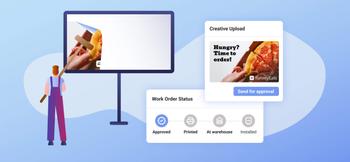In case you missed it, we recently held a product-focused webinar highlighting how the Broadsign Platform for static management can help you break silos between your teams, drive more revenue, centralize your operations and make data-driven decisions. Hosted by our Product Marketing Specialist, Catherine Lee, she discussed with our in-house static experts, Senior Product Manager, Myriam Bordeleau, and Senior Product Specialist, Sander Nijs, what the current pitfalls with traditional out-of-home (OOH) management are, and how Broadsign Static Campaigns can address these challenges for media owners.
Pitfalls with traditional OOH management – as told by static media owners
As a special gift to our attendees, we gave them a sneak peek into some of the results from the State of Static OOH survey that we recently conducted. Wanting to get a better understanding of some of the existing and future challenges static media owners face, we surveyed owners with static inventory from across the globe. Here’s a quick summary of some of the insights we shared:
87.3% of respondents feel there is room to automate the static OOH management process
As media owners, you’re undoubtedly familiar with the challenges of manual workflows. The lack of automation in the current static OOH management process consumes valuable time and resources, hindering your growth. Moreover, these manual processes often lead to errors, translating into financial setbacks.
Growing advertising revenue, driving operational efficiency and digitization are the top 3 concerns over the next three years for static media owners
69.84% of respondents see growing advertising revenue as a significant operational challenge, indicating a strong focus on revenue generation and the need to enhance strategies to increase advertiser preference for using OOH.
It’s no secret that out-of-home campaigns, especially static OOH, are intricate, have many moving parts, and thus require meticulous oversight. Without a way to easily monitor the process from proposal to posting, which often involves various departments and vendors, your operational efficiency will likely fall short of its potential.
Finally, nearly half of respondents foresee challenges related to digitization and technology, highlighting the rapidly evolving technology landscape and the need to adapt and integrate digital solutions into operations. It will be crucial for organizations to stay up-to-date with technology trends, upskill employees, and invest in digital infrastructure to remain competitive.
Inventory availability and proposal management are currently the biggest challenges in the static campaign workflow for most respondents
Out-of-home advertising, especially static OOH, is often perceived as sluggish by advertisers. With long turnaround times on proposals and campaign delivery, advertisers often do not immediately think to include OOH in their media buy, opting for other, seemingly faster, media forms. This often results in your sales team potentially losing deals due to slow turnaround times or lack of insights from other departments on availability.
How Broadsign Static Campaigns addresses these pitfalls
While the results from our survey that we shared above may not be news to many of us, the pain points respondents pointed out align with why we created our solution for static campaign management in the Broadsign Platform. Addressing only the pain points highlighted in this webinar, let’s dive into how our core static capabilities alleviate these challenges – for further details on how the Broadsign Platform can help you at every stage of your static workflow, check out this previous blog post.
Book campaigns in minutes instead of days with real-time availability
The first capability we’d like to highlight and that is of great interest to all media owners is real-time inventory availability. Your sales team is given visibility into assets that are booked, held and available for sale, all in one centralized view.
Plus, with access to the same information that your Charting team has, gone are the days of endless back and forth between Sales and Charting. With an extensive list of filters to match the targeting criteria, sales can quickly select the ideal inventory for the campaign and create the proposal, allowing them to get back to the advertisers in a matter of minutes rather than days.
Here’s Myriam to tell you more about real-time availability:
Get a bird’s eye view of all your production and installation activities
The production, printing and installation of OOH creatives have many moving parts, which means your operational efficiency is measured based on how easily you can monitor and manage poster orders, poster stock, warehouse activities, and vendor management. With the Broadsign Platform, we track various activities related to poster allocation – from ordering and receiving the copies in the warehouse to their campaign allocation and posting status.
Here’s Myriam again with more on how we’ve simplified work orders:
Empower your teams to make confident, data-driven decisions
Today’s advertisers expect to have access to campaign analytics and performance when running an OOH campaign. Our static solution gives everyone in the business access to insightful reporting and analytics – both out of the box and via API.
In addition to all the reporting capabilities you would expect from a static OOH management solution, like sales, pipeline and availability reports, we also have capabilities that can help remove a lot of manual calculations. For example, separating the media costs from the production costs are things that not only usually take time but are often managed by different people.
Moreover, with all of your data centralized in one platform, you’ll have a complete view of your business that allows you to see where you’re doing well and where you need to focus more energy and resources.
But that’s enough of us telling you how great our solution is; here’s a quick video of our Senior Product Specialist, Sanders Njis, demonstrating what you can do in the Broadsign Platform for static campaign management:






